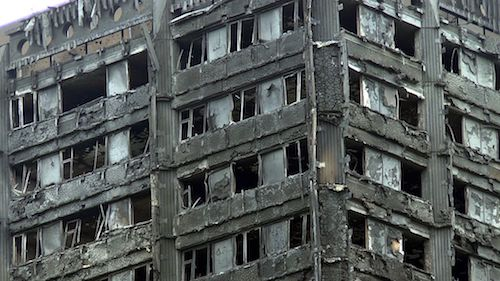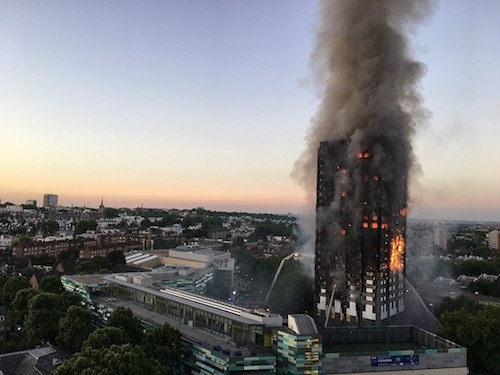First-Phase Grenfell Tower Fire Inquiry Report Released
MONDAY, NOVEMBER 4, 2019
The long-awaited report from the first phase of London’s Grenfell Tower Fire inquiry was released last week, criticizing not only the response to the fire but the tower’s 2016 renovation.
Arguably of most importance, inquiry chairman Martin Moore-Bick said that it seems that the refurbishment did not comply with the building regulations requirement to adequately resist the spread of fire.
“There is compelling evidence that Requirement B4(1) was not met in this case,” he said. “It would be an affront to common sense to hold otherwise.”
Some Background
On June 14, 2017, Grenfell Tower—a 24-story, 120-home apartment building—caught fire and resulted in the death of 72 people. While the fire started in a fridge-freezer in an apartment on the fourth floor, the blaze then spread to a nearby window. The building had recently undergone a $12.73 million renovation designed by Studio E Architects that was completed in the spring of 2016 and is largely believed to be responsible for why the fire spread so quickly.
At that time, the building was refurbished with a system of polyester powder-coated aluminum rain-screen panels, insulated exterior cladding and double-glazed windows, as well as a communal heating system.

 |
| ChiralJon, CC-SA-BY 2.0, via Wikimedia Commons |
|
The long-awaited report from the first phase of London’s Grenfell Tower Fire inquiry was released last week, criticizing not only the response to the fire but the tower’s 2016 renovation. |
A Guardian investigation in 2018 revealed that nonflammable aluminum panels had initially been proposed for the refurb but were switched out to save money.
The publication found that, at first, under the local government’s preferred contractor, Leadbitter, subcontractor D+B Facades had provided a 3.3 million-pound (roughly $4.1 million) quote to fit a system of aluminum panels backed with mineral wool insulation.
A few months later, the council decided that Leadbitter wanted to spend too much on the refurbishment, and put the contract out to tender to save about 1.3 million pounds. It went with a different contractor, Rydon, which provided a lower bid, but fitted the tower with the combustible cladding that authorities believe contributed to the number of fatalities in the fire.
The Guardian found that the council had originally wanted to spend 6 million pounds on Grenfell, but later set a different budget of 9.7 million pounds, because it realized it needed to replace the heating system. Leadbitter was on course to spend 11.3 million pounds, which is why council says it put the contract back out.
Manufacturer Omnis Exteriors confirmed that they supplied the Arconic Architectural Product to Harley Facades—the subcontractor that Rydon utilized for the cladding work.
Around the same time in 2018, BBC News uncovered that the Reynobond PE cladding was subjected to European tests in 2014 and 2015 for “reaction to fire,” in which products are typically given an A to F rating, with A being the highest.
(Many officials believed that the legal standard for such towers was a B rating. While that belief had been contested among industry professionals, the legal minimum rating now, post-Grenfell fire, has been upgraded to A.)
The reports from the 2014-15 tests reveal that two types of the Reynobond, both of which were installed at Grenfell, had less than B ratings. One type, called “riveted,” received a C classification, while another, “cassette,” received an E classification.
The BBC obtained correspondence from Arconic to clients confirming the ratings.
The Report
The first phase was officially published on Oct. 30 and contained a 1,000-page report informed by 50,000 pages of evidence. This phase was to focus solely on the events the nights of the fire, while more details in the refurbishment of the building are set to be examined in phase two.
 |
| Natalie Oxford, CC-SA-BY 4.0, via Wikimedia Commons |
|
The first phase was officially published on Oct. 30 and contained a 1,000-page report informed by 50,000 pages of evidence. This phase was to focus solely on the events the nights of the fire, while more details in the refurbishment of the building are set to be examined in phase two. |
The report concluded, as did other investigations, that the cause of the fire was an electrical fault in a fridge-freezer in Flat 16, though Moore-Bick said the cause was less important than “establishing how the failure of a common domestic appliance could have such disastrous consequences.”
In addition to the preliminary conclusions on the 2016 refurbishment, the report also accuses the fire brigade’s response to the fire as having “systematic failures” with no contingency plan to evacuate the tower. It also criticized the brigade’s decision to maintain the “stay-put policy” even when the stairs were passable.
The attack on the firefighters has been met with mixed messages, with some saying the inquiry is treating rescue services as a scapegoat for the failures of the building.
“The truth is that the fire spread the way it did because it was wrapped in flammable cladding,” general secretary of the Fire Brigades Union, Matt Wrack, told the BBC. “The firefighters turned up after that had happened, after the building had already been turned, in reality, into a death trap.
“Firefighters’ actions on the night, which were remarkable in the circumstances, are now being scrutinized. Nobody is trying to avoid scrutiny, but we think that the ordering of the inquiry is completely back to front.”
Moore-Bick made several recommendations to the government in the report, including:
- Revised evacuation plans for all high-rise buildings;
- The mandate that owners and managers of residential towers should inform fire services about design and construction materials;
- Up-to-date floor plans;
- Updated signage in all stairways and lobbies;
- Regular inspections of elevators; and
- The regular inspection of fire doors.
With the release of the report, British Prime Minister Boris Johnson said that those affected by the Grenfell Tower fire were “overlooked before the tragedy and failed following it.”
"No report, no words, no apology will ever make good the loss suffered and the trauma experienced,” he said.
Tagged categories: Cladding; Condominiums/High-Rise Residential; Fire; Government; Health and safety; Maintenance + Renovation; Renovation; Safety









